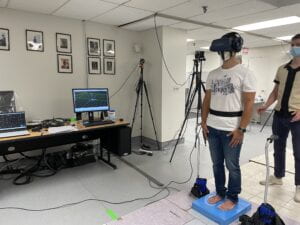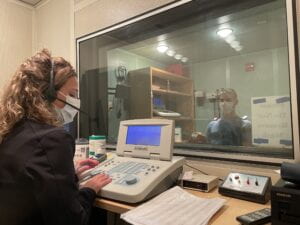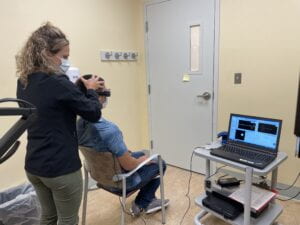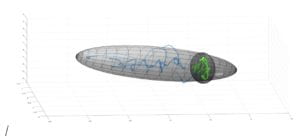Ongoing Projects
Sensory integration of auditory and visual cues in diverse contexts given age, vestibular hypofunction and hearing loss
More than 1/3 of adults in the United States seek medical attention for vestibular disorders and hearing loss; disorders that can triple one’s fall risk and have a profound effect on one’s participation in activities of daily living. Hearing loss has been shown to reduce balance performance and could be one modifiable risk factor for falls. Patients with vestibular hypofunction tend to avoid busy, hectic, visually complex, and loud environments because these environments provoke dizziness and imbalance. While the visual impact on balance is well known, less is known about the importance of sounds for balance.
This research, funded by the NIDCD will answer the following questions: (1) Are sounds used for balance and if yes, via what mechanism? (2) Do individuals with single-sided hearing loss have a balance problem even without any vestibular issues? (3) Are those with vestibular loss destabilized by sounds?
Eligibility:
Patient groups:
1. Adults with a clinical diagnosis of chronic unilateral vestibular hypofunction, no hearing loss, no neuropathy and normal or corrected to normal vision.
2. Adults with a diagnosis of unilateral sensorineural hearing loss and no vestibular condition, no neuropathy and normal or corrected to normal vision.
Control group: Healthy adults (18 or older) with no hearing loss, vestibular loss or other neurological conditions. Normal or corrected to normal vision.
Contact: anat@nyu.edu



Recently Completed Projects:
Vestibular Rehabilitation utilizing Virtual Environments to Train Sensory Integration for Postural Control in a Functional Context
We created a clinical virtual reality application for a Head Mounted Display (HMD, e.g., HTC Vive) to provide a graded method for patients to experience complex environments in a functional and non-threatening context. Our HMD app allows for contextual sensory integration (C.S.I.) where patients are immersed in safe, increasingly challenging environments while practicing a variety of tasks (e.g., turning, walking, dodging, etc.). These environments are designed to mimic visual and auditory loads that patients may interact with in their daily living and are not easily reproducible in traditional rehabilitation.
In this project, funded by NIH REACT, we will determine the extent to which sensory integration strategies differ between individuals with unilateral vestibular hypofunction and age-matched peers. We will then develop the protocol and establish the feasibility of a randomized controlled trial (RCT) comparing C.S.I training to standard vestibular rehabilitation.

Eligibility:
Patient groups: Adults with a clinical diagnosis of chronic unilateral vestibular hypofunction, no hearing loss, no neuropathy and normal or corrected to normal vision.
Control group: Adults with no neurological condition who are matched in age and sex to the patient group.
Contact: anat@nyu.edu
A balancing act in hearing and vestibular loss: assessing auditory contribution to multisensory integration for postural control in an immersive virtual environment
It has been shown that hearing loss may play a role in postural control, but hearing status is rarely examined in balance/ fall risk assessments. Our long-term goals are to answer the following: 1) should a complete audiometric evaluation be part of standard balance screening? 2) should auditory cues be included in balance assessment and fall prevention programs? and 3) would rehabilitation of hearing loss improve balance?
In this project, funded by the Hearing Health Foundation, we will compare weighting and reweighting of visual and auditory input given mild somatosensory perturbation (stable vs. compliant surface) as well as head kinematics and gaze behavior between individuals with unilateral sensorineural hearing loss to those with unilateral vestibular dysfunction without hearing loss and healthy controls.
Eligibility:
Patient groups:
- Adults with a clinical diagnosis of chronic unilateral vestibular hypofunction, no hearing loss, no neuropathy and normal or corrected to normal vision.
- Adults with a diagnosis of unilateral sensorineural hearing loss and no vestibular condition, no neuropathy and normal or corrected to normal vision.
Control group: Healthy adults (18 or older) with no hearing loss, vestibular loss or other neurological conditions. Normal or corrected to normal vision.
Contact: anat@nyu.edu


